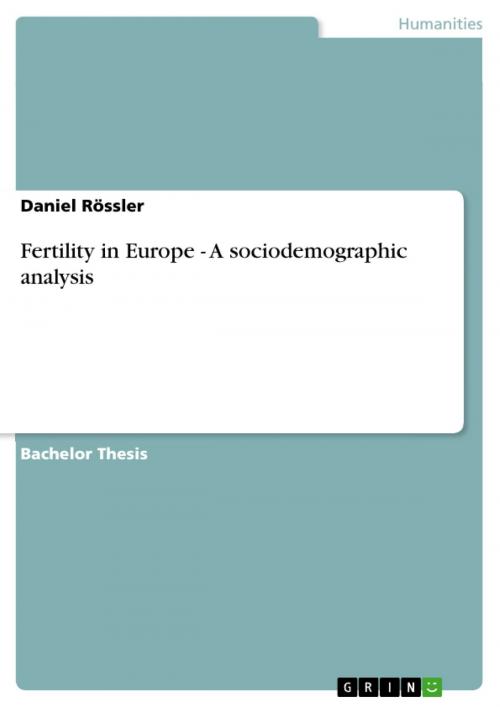Fertility in Europe - A sociodemographic analysis
A sociodemographic analysis
Nonfiction, Social & Cultural Studies, Social Science, Sociology| Author: | Daniel Rössler | ISBN: | 9783638033305 |
| Publisher: | GRIN Publishing | Publication: | April 7, 2008 |
| Imprint: | GRIN Publishing | Language: | English |
| Author: | Daniel Rössler |
| ISBN: | 9783638033305 |
| Publisher: | GRIN Publishing |
| Publication: | April 7, 2008 |
| Imprint: | GRIN Publishing |
| Language: | English |
Bachelor Thesis from the year 2005 in the subject Sociology - Gender Studies, grade: 1,0, University of Vienna (Institut für Soziologie), 27 entries in the bibliography, language: English, abstract: The world's demographic situation is a paradox one. While the global population is growing dramatically and lots of countries are confronted with the problem of an uncontrolled and drastically birth surplus, many nations are facing demographic difficulties reversely. Both tendencies are holding formidable intricatenesses - by economic, environmental as well as by social nature. Despite the sum of political activities implemented in nearly all societal areas, European countries are holding the lowest rates of fertility worldwide - an average European woman gives birth to 1,43 children today. Compared to Africa and Asia, where 4,68 respectively 2,35 children are born by a single woman, the value appears dramatically and is understandably providing a basis for fervid, often irrational and populist discussions and agitations. But even when keeping distance to embroidering scenarios and apocalyptic prospects, certain demographic imbalances cannot be negated. The continuous decrease of birth rates in nearly all European countries has to be accepted as an incontrovertible fact. Nevertheless there's nothing like an 'European Consistency' regarding the character and pace of regressing birth rates, but a plurality of different demographic developments with disparate velocity and determinated by unequal terms. Considering the demographic reality of Europe matter-of-factly, this paper will try to trace the pattern of natalistic developments in the European Union against the background of specific national, social, political, economical, religious and cultural contexts. On the one hand, demographic realities of the Member States will be compared with each other, whereas country-specific peculiarities will be taken into consideration as well as cross-national phenomena. On the other hand, the attempt of an embedding of just those demographic realities into their socio-cultural contexts will be carried out. By establishing a connection between demographic data and its societal provenience, fertility-related developments will be represented as cross-linked, multi-layered processes. Due to the complexity of the subject, interrelations will be established merely with selected causal factors.
Bachelor Thesis from the year 2005 in the subject Sociology - Gender Studies, grade: 1,0, University of Vienna (Institut für Soziologie), 27 entries in the bibliography, language: English, abstract: The world's demographic situation is a paradox one. While the global population is growing dramatically and lots of countries are confronted with the problem of an uncontrolled and drastically birth surplus, many nations are facing demographic difficulties reversely. Both tendencies are holding formidable intricatenesses - by economic, environmental as well as by social nature. Despite the sum of political activities implemented in nearly all societal areas, European countries are holding the lowest rates of fertility worldwide - an average European woman gives birth to 1,43 children today. Compared to Africa and Asia, where 4,68 respectively 2,35 children are born by a single woman, the value appears dramatically and is understandably providing a basis for fervid, often irrational and populist discussions and agitations. But even when keeping distance to embroidering scenarios and apocalyptic prospects, certain demographic imbalances cannot be negated. The continuous decrease of birth rates in nearly all European countries has to be accepted as an incontrovertible fact. Nevertheless there's nothing like an 'European Consistency' regarding the character and pace of regressing birth rates, but a plurality of different demographic developments with disparate velocity and determinated by unequal terms. Considering the demographic reality of Europe matter-of-factly, this paper will try to trace the pattern of natalistic developments in the European Union against the background of specific national, social, political, economical, religious and cultural contexts. On the one hand, demographic realities of the Member States will be compared with each other, whereas country-specific peculiarities will be taken into consideration as well as cross-national phenomena. On the other hand, the attempt of an embedding of just those demographic realities into their socio-cultural contexts will be carried out. By establishing a connection between demographic data and its societal provenience, fertility-related developments will be represented as cross-linked, multi-layered processes. Due to the complexity of the subject, interrelations will be established merely with selected causal factors.















